
Similar to many areas in the tropics, the Costa Rican provinces of Guanacaste and Alajuela have a rich history of human interaction and influence, from early indigenous peoples who scientists believe extirpated most of the major megafauna mammals of the region, to the era of Spanish conquest and widespread deforestation for cattle ranching, to the formation of the modern states of Costa Rica and Nicaragua in this border region, and, eventually, to the development of Costa Rica’s national system of parks and protected areas. ACG is perhaps the only major protected area in the tropics that deliberately puts the word “development” on its entrance sign, with the principle of biodevelopment being a guiding philosophy for how the parks and protected areas of ACG should be managed. This principle emphasizes mutualistic non-damaging development for the benefit of people and wildlife through employment, education, research, and access for non-damaging uses. Key resources for understanding how the philosophy of biodevelopment has been shaped and implemented in ACG can be found in various publications, videos and articles, including the following:
- Overview 8-minute video narrated by Róger Blanco, the subdirector of ACG, who describes the operating philosophy of ACG conservation management (English subtitles in process).
- The Green Phoenix, a book by journalist Bill Allen that focuses on the lively political and social development of ACG in its first 25 years. This book, originally published in 2001, is still a fascinating read. Bill is presently working on a sequel.

- In 2010, the late videographer Luciano Capelli made a 56-minute film, Se Quema El Cielo, about the history of cattle farming, the role of fire, and the conservation efforts to restore the once vibrant tropical dry forest that is now a major part of ACG (with English subtitles).
- Like the rest of Mesoamerica, the Guanacaste region has a very rich history of pre-European occupation. The dominant tribe of this region was the Chorotega; the custom and artwork of the tribe are interwoven through the communities of today's Guanacaste province and Nicoya Peninsula. Read more here, here and here.
- Articles on the role and evolution of resident parataxonomists, who are career scientists drawn from their rural communities and trained to do high level scientific research across a dozen research stations within ACG terrestrial and marine environments can be found here, here, and here.
- A History of How ACG Came to Be ACG. This article, in the journal BioTropica, penned by Dan Janzen and Winnie Hallwachs, is an excellent historical tour of the creation of ACG.
